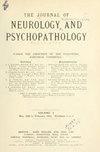PROGNOSIS AND TREATMENT
引用次数: 0
Abstract
nulliparae showed 63 per cent. asymptomatic, 29 per cent. parel-lchymatous, and 8 per cent. meningovascular neurosyphilis; multipare showed 54 per cent. asymptomatic, 38 per cent. parenchymatous, and 8 per cent. meningovascular neurosyphilis. Wl hen arranged in the age groupinigs the nullipare showed a preponderance of cases in the third decade (ages 20 to 29) and a very snmall percentage after 40 years of age. In contrast, the miales and niultiparae showed the peak in the fourth decade (ages 30 to 39) with a much higher incidence after this period than in the case of the nulliparte. A detailed analysis of the iincidence of each clinical type in each age grouping is shown in tables. R. G. G.预后与治疗
无症状者为63%,平行脓肿者为29%,脑膜血管性神经梅毒者为8%;多组显示无症状者占54%,实质性病例占38%,脑膜血管性神经梅毒占8%。当按年龄分组排列时,在第三个十年(20至29岁)的病例占多数,而在40岁以后的病例占很小的比例。相比之下,乳母和乳母在第四个十年(30至39岁)达到高峰,此后的发病率远高于乳母。表中显示了每种临床类型在每个年龄组的发病率的详细分析。r.g.g g。
本文章由计算机程序翻译,如有差异,请以英文原文为准。
求助全文
约1分钟内获得全文
求助全文

 求助内容:
求助内容: 应助结果提醒方式:
应助结果提醒方式:


